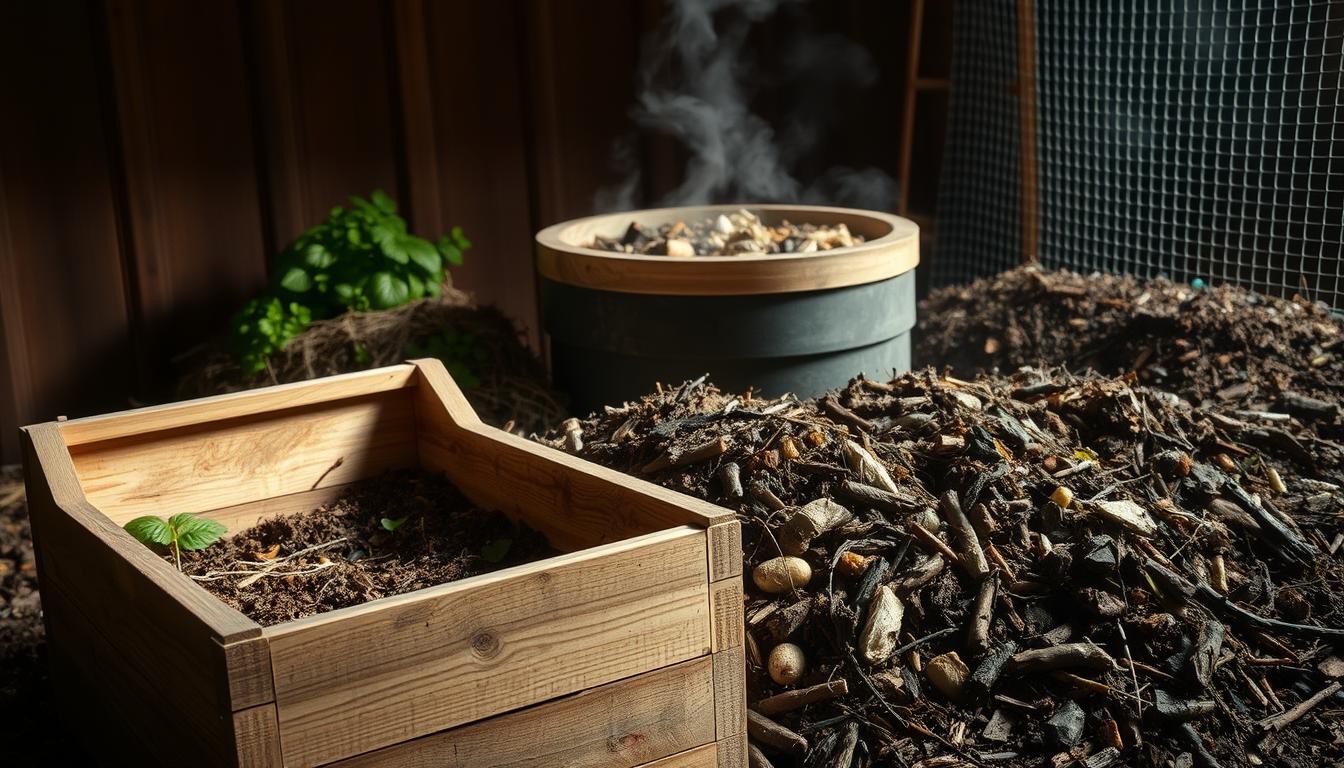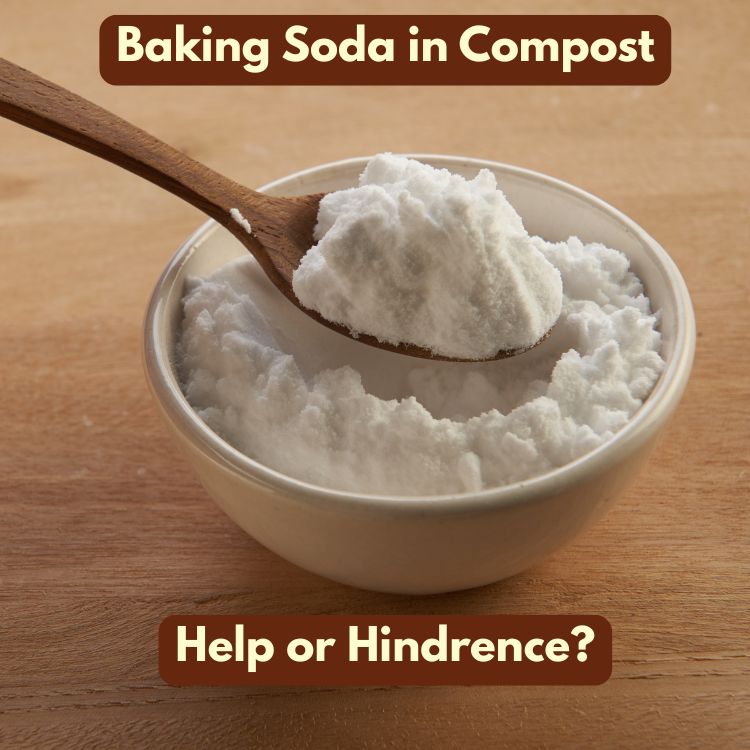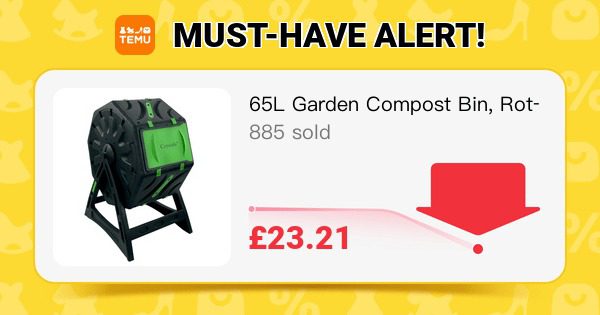Help or Headache?
2025 Guide for Composting, Vermicomposting, and Compost Tumbler Users
Ever wondered if tossing a bit of baking soda in compost will keep things fresh or ruin the whole mix?
You’re not alone—many home composters, especially those trying out vermicomposting or using a compost tumbler, are curious about whether this household staple is a shortcut to a sweet-smelling heap or a recipe for disaster.
The answer isn’t as simple as yes or no.
This post looks at what really happens when baking soda hits your compost pile. You’ll find out how it affects microbes, worms, and the science behind a healthy, balanced composting environment.
We’ll also touch on different composting methods, from backyard bins to tumblers, so you know what works best for your setup.
Understanding the right balance keeps your compost thriving and makes sure you’re not creating more problems than you solve.
If you’re looking for smart ways to layer and maintain a healthy pile, you might want to check out the Compost Layering Method for some handy strategies.
Understanding Baking Soda: What It Does in Compost
Ever tried to fix a smelly compost pile with a sprinkle of baking soda?
You’re in good company! But before tossing that white powder into your tumbler or bin, it helps to know what’s actually happening.
Baking soda in compost isn’t always a quick fix—sometimes it brings more surprises than solutions.
Let’s break down how baking soda works in your heap and how it changes the microscopic world inside.

How Baking Soda Changes Compost pH
Adding baking soda—also known as sodium bicarbonate—shifts your compost’s pH toward the alkaline side. That means your pile becomes less acidic and more basic.
Why does this matter?
Because composting is a team effort, and your best workers are the microbes and worms that thrive at certain pH levels.
When you add too much baking soda in compost, here’s what happens:
- The pH creeps up, making the environment less comfortable for composting microbes and worms, especially those in vermicomposting setups.
- Microbial activity can slow down. These tiny helpers actually prefer a compost pH close to neutral—slightly on the acidic side.
- The breakdown rate drops. Less active microbes mean slower transformation from food scraps to rich, crumbly compost.
Think of it like setting the bathwater too hot or cold for your pets—they’ll avoid it. For compost, an off-balance pH is a warning sign that something’s not right.
Some gardeners use a pinch to control odors, but it’s easy to overdo and harm the helpful community in your bin or compost tumbler.
Curious about tips for keeping your pile balanced? The Backyard Boss guide to composting with baking soda has helpful advice for managing acidity without going overboard.
Science of Decomposition: Microbes and Baking Soda
What makes compost, well, compost? Microbes!
These are the real powerhouses—bacteria, fungi, and even tiny insects that chew through leftovers and turn them into garden gold.
Microbes love steady moisture, air, and a pH that isn’t too extreme.
Sprinkling baking soda in compost sends ripples through your pile’s ecosystem:
- Some bacteria can handle a little more alkalinity, but most compost microbes don’t work as fast when conditions change.
- Fungi and helpful worms, especially in vermicomposting, may slow down or disappear if the environment shifts too far.
- Too much baking soda may reduce some smells, but it can cause your compost to lose steam—the pile stays crunchy and slow to finish.
On the flip side, a small pinch in a huge and very acidic pile might help for a moment.
But it’s a risky move to rely on baking soda instead of balancing greens (nitrogen-rich) and browns (carbon-rich).
If you’re after compost with a sweet smell and a speedy process, moderating pH with good mixing and the right layers works better.
For an inside look at how microbes support decomposition (and why they hate harsh chemicals), check out this friendly breakdown on baking soda’s interaction with compost microbes.
Remember, the real stars of decomposition are your bin’s tiny residents.
If you feed them well, they’ll reward you with the compost your plants love!
 Photo by Tatana
Photo by Tatana
Want more details on composting basics or curious about managing worm bins?
Check out the composting FAQ bot for instant composting advice to find quick, reliable answers tailored to your compost style.
Should You Add Baking Soda to Compost? Pros and Cons
The idea of sprinkling baking soda in compost is tempting when your bin gets smelly or fruit flies pay a visit. Some folks use it with hopes of controlling odor or taming pests, but there are tradeoffs.
Let’s look at what really happens—both the upsides and the drawbacks—so you can make compost that’s healthy and hassle-free, whether you’re using a classic heap, a compost tumbler, or even a worm bin for vermicomposting.
Smell Control and Pest Prevention: What Does Baking Soda Actually Do?
 Photo by Rachel Loughman
Photo by Rachel Loughman
The myth: sprinkle a bit of baking soda in compost and poof—no more stinky bin or buzzing flies. In truth, baking soda can neutralize acids and cut some surface odors for a short time, since it reacts with foul-smelling acids to form mild salts.
But the magic ends there.
Ask any veteran composter and they’ll tell you: the smell and pest problems often come from having too many “greens” (wet, smelly scraps) and not enough “browns” (dry stuff like leaves, cardboard, or paper).
Baking soda doesn’t fix a soggy, imbalanced pile—it just covers it up for the moment.
And while you might see fewer flies, you also risk upsetting the microbes and worms you need for speedy, healthy compost.
Here’s what to try instead:
- Balance Greens and Browns: Mix moist kitchen scraps with dry leaves, shredded paper, or small wood chips. The right ratio cuts odor and keeps pests away.
- Turn Your Pile Often: Mixing lets air in and helps break down material faster (goodbye, bad smells).
- Cover Food Scraps: Bury new scraps in the center of your compost or under a brown layer.
- Monitor Moisture: Squeeze a handful of compost—it should feel like a wrung-out sponge, not a swamp.
Interested in keeping things fresh naturally?
Learn practical tips for an odor-free compost bin or see how everyday “browns” such as cardboard make all the difference in this composting thread.
A well-balanced bin smells earthy, never rotten, and always stays fly-free—without extra chemicals.

Risks: Microbial Health and Compost Quality
Baking soda in compost may seem harmless, but using it the wrong way brings risks. In compost and vermicomposting, the good stuff happens when microbes—tiny bacteria and fungi—work together to break everything down.
Baking soda raises the pH, and even simple changes can throw these hard-working microbes off track.
What can go wrong?
- Overuse raises alkalinity, knocking out the bacteria and fungi that do the heavy lifting.
- The breakdown process slows, or even stops, since the right microbes can’t survive.
- Worms dislike high pH—your vermicomposting friends may crawl away or die off.
When this happens, nutrients in your compost drop. You end up with unfinished, low-quality compost that won’t help your garden flourish.
Keeping things healthy means knowing your pile:
- Check pH if your compost seems slow or smells off. Kits are cheap and easy to use.
- Turn the pile to maintain even air and moisture.
- Watch for signs: Healthy compost is crumbly and smells like soil, not ammonia or vinegar.
If you want to dig into the science, this article on microbial indicators in compost explains how microorganisms shape compost quality. For tips on monitoring and supporting microbial diversity, see Ensuring Quality in Compost.
Thinking about starting from scratch, or refreshing your skills? Here’s a friendly guide on how to Begin Composting at Home that covers every step for a thriving, microbe-friendly bin.
In short: A happy compost pile has a bustling, balanced microbe crew. Let nature handle the odors.
Skip the quick fixes and focus on balance and care for your compost, compost tumbler, or worm bin.
Where Baking Soda Might Help: Special Cases and Alternatives
Not every composting headache needs baking soda, but there are times when it can help if you use it sparingly and wisely.
This section looks at when limited baking soda is okay, smarter ways to beat bad smells or pests, and tips for protecting your compost tumbler or worm bin from big pH swings.
Getting to know these differences can save your compost from trouble and keep things running smooth.
Small-Scale Problem Solving: When Baking Soda Makes Sense
Most compost bins do not need a dose of baking soda. But, in small, specific situations, it can help if you keep a light hand:
- Maggot Infestation: If you spot maggots wriggling on the surface of your pile, a tiny sprinkle of baking soda across the area can help dry them out. This should only be a surface treatment, and only when the issue is limited—not deep in the heap.
- Strong Surface Odors: Sometimes, a smelly compost surface is the result of too many food scraps or an acidic spike. A light dusting of baking soda can neutralize odor for a short time, giving you space to fix the bigger problem.
Always use only a small amount—less than a teaspoon for a regular-sized home bin.
Piling on baking soda can cause pH problems fast and disrupt the natural composting process.
Moderation really matters here; if you think you need to keep adding more, it’s time to step back and check your compost’s balance.
A good tip from composting communities: alternatives like activated charcoal may work as well or better, helping with odor without upsetting your compost’s natural chemistry.
Take a peek at this discussion about refrigerator baking soda in compost bins for more friendly advice.
Better Alternatives for Healthy Compost
Before reaching for the baking soda, there are time-tested ways to keep compost in top shape.
Try these proven fixes to avoid pest or smell issues and support a strong, active bin:
- Increase Carbon: Add dry leaves, shredded cardboard, or twigs if your compost gets soggy or starts to stink. These browns soak up moisture and keep odors in check.
- Routine Turning: Use a shovel or fork to turn your pile every week or two. This introduces air and helps microbes break down scraps quickly.
- Proper Moisture: Compost should be damp, like a wrung-out sponge. If it’s too wet, add more dry browns. If it’s dry, sprinkle in a little water.
- Layer Materials: Try alternating layers of green scraps (like peels and coffee grounds) with brown, carbon-rich materials to encourage steady breakdown.
- Good Bin Care: Keep your compost bin covered, and bury new scraps under the surface to keep pests and flies away.
Mixing these small changes into your routine will bring better results than baking soda alone. Learn practical ways to use unexpected household scraps in your bin by visiting Composting Tips: Don’t Toss It.
You might also want to check out natural pest deterrents, such as using neem oil or introducing beneficial nematodes instead of chemical fixes.
This overview of baking soda and plant care highlights alternatives like neem oil that are safer for your pile and garden.
Compost Tumbler and Vermicomposting Advice
Compost tumblers and worm bins (vermicomposting systems) are even more sensitive to big changes in pH.
Baking soda in compost is risky for these systems because:
- Tightly Sealed Systems: Tumblers and worm bins trap changes faster than open piles.
- Compact Space: A little baking soda shifts pH more dramatically in smaller, enclosed bins.
- Worm Sensitivity: Compost worms hate rapid pH swings and can escape or die off if conditions become too alkaline.
To care for these systems:
- Balance Inputs: Never add large amounts of citrus, vinegar, or baking soda—keep everything moderate.
- Turn or Roll the Bin: With tumblers, give the composter a few spins every week to let air in and keep breakdown on track.
- Bury Food Scraps: For worm bins, tuck new scraps just under the bedding and add extra shredded paper to soak up any soggy spots.
- Test pH Periodically: Use a simple soil pH tester if things seem off. Neutral to slightly acidic is best.
Want more details on managing each system?
Read Tips for Using Compost Tumblers for smart tumbler tricks, or check out the Home vermicomposting guide for worm bin know-how you can start using today.
 Photo by Alfo Medeiros
Photo by Alfo Medeiros
Keeping your compost, tumbler, or worm bin healthy takes simple steps and attention instead of quick fixes.
A balanced bin beats a chemical band-aid every time, and the result is compost you’ll feel proud to use in your garden.
Conclusion
Baking soda in compost can be helpful for very specific issues, like surface smells or maggot troubles, but should always be used with a light hand.
The real secret to a thriving compost or vermicomposting bin is balance—keep your greens and browns in check, turn your pile, and add moisture when needed. Most of the time, simple steps work better than quick fixes.
If you want more creative ways to manage odor or pests—especially in tight spaces—take a look at these small backyard composting tips. Go ahead and experiment, just remember: healthy compost doesn’t need much help from baking soda.
Stay curious, keep learning, and your compost tumbler or worm bin will reward you with garden gold. Thanks for reading—share your composting wins and lessons so others can grow along with you!






It was good content. It helped me a lot.
Thank you
Thanks . I do vermi and garden and didn’t realise some folk add baking soda. I also assist folks with composting so find ur info enlightening. Thanks